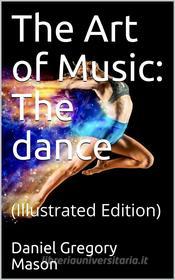
Ebook The Dance
- Editore:
iOnlineShopping.com
- EAN:
9788832548488
- Formati:
- Pdf, Mobipocket
- Protezione:
- Nessuna
Descrizione Ebook The Dance
A Comprehensive Library of Information
for Music Lovers and Musicians
Introduction
‘The gods themselves danced, as the stars dance in the sky,’ is a saying of the ancient Mexicans. ‘To dance is to take part in the cosmic control of the world,’ said the ancient Greek philosophers. ‘What do you dance?’ asks the African Bantu of a member of another tribe after his greeting. Livingston said that when an African wild man danced, that was his religion. It is said that the savages do not preach their religion but dance it. According to the Bible, the ancient Hebrews danced before their Ark of the Covenant. St. Basil describes the angels dancing in Heaven. According to Dante, dancing is the real occupation of the inmates of Heaven, Christ acting as the leader of a celestial ballet. ‘Dancing,’ said Lucian, ‘is as old as love.’ Dance had a sacred and mystic meaning to the early Christians upon whom the Bible had made a deep impression: ‘We have piped unto you and ye have not danced.’
The service of the Greek Church—even to-day—is for the most part only a kind of sacred dance, accompanied by chants and singing. The priest, walking and gesturing with an incense-pan up and down before the numerous ikons, kneeling, bowing to the saints, performing queer cabalistic figures with his hands in the air, and following always a certain rhythm, is essentially a dancer. It is said that dancing of a similar kind was performed in the English cathedrals until the fourteenth century. In France the priests danced in the choir at the Easter Mass up to the seventh century. In Spain similar religious dancing took deepest root and flourished longest. In the Cathedrals of Seville, Toledo, Valencia and Xeres the dancing survives and is the feature at a few special festivals.
‘The American Indian tribes seem to have had their own religious dances, varied and elaborate, often with a richness of meaning which the patient study of the modern investigators has but slowly revealed,’ writes Havelock Ellis. It is a well-known fact that dancing in ancient Egypt and Greece was an art that was practiced in their temples. ‘A good education,’ wrote Plato, ‘consists in knowing how to sing well and how to dance well.’ According to Plutarch, Helen of Sparta was practicing the Dance of Innocence in the Temple of Artemis when she was surprised and carried away by Theseus. We are told by Greek classics that young maidens performed dances before the altars of various goddesses, consisting of ‘grave steps and graceful, modest attitudes belonging to that order of choric movement called emmeleia.’ The ancient Egyptian Astronomic Dance can be considered the sublimest of all dances; here, by regulated figures, steps, and movements, the order and harmonious motion of the celestial bodies was represented to the music of the flute, lyre and syrinx. Plato alludes to this dance as ‘a divine institution.’
Dancing and architecture are the two primary and plastic arts: the one in Time, the other in Space; the one expressing the soul directly through the medium of the human body, the other giving only an outline of the soul through the medium of fossilized forms. The origin of these two arts is earlier than man himself. Both require mathematics, the one rhythmically, the other symmetrically. For dancing the mathematical forms are to be found in music, for architecture, in geometry. ‘The significance of dancing, in the wide sense, thus lies in the fact that it is simply an intimate concrete appeal of that general rhythm which marks all the physical and spiritual manifestations of life,’ writes Havelock Ellis.


